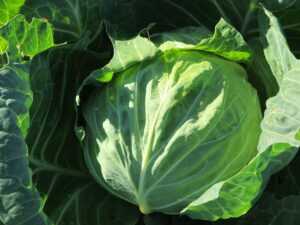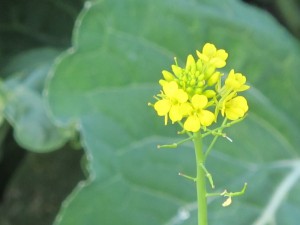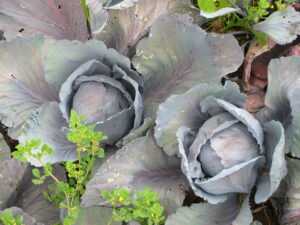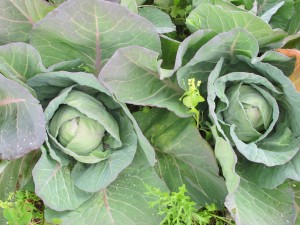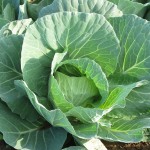Love is Like a Cabbage
My love is like a cabbage Divided into two, The leaves I give to others, The heart I give to you.
(In honor of Valentine’s Day this week)
This time of the year marks the peak for the amiable Brassicaceae family that grows in our field throughout the wintertime: broccoli, cauliflower, cabbage and kohlrabi. This week we dedicate our newsletter to the “ancient” member of the bunch– the cabbage. You’ve been enjoying his visits for so long that some of you have begun treating him like a guest who forgot to leave… So, to remind you how much you should love and appreciate him, this newsletter is his.
(This week’s photos were taken by Chana, whose photographs are on your calendars. How beautiful are they?!)
Throughout history, the cabbage has known many ups and downs. The Greeks loved it for its medicinal attributes, but the medieval aristocracy turned up its nose at the mere mention of the vegetable. If you were to heed a Roman scholar from the 2nd century BC, you’d eat lots of fresh cabbage seasoned in vinegar if you intend to imbibe. The Egyptians suggested beginning your meal with fresh cabbage, including its seeds, in order to remain sober till the end of the meal. Seems like the common cure for hangovers was the consumption of more and more cabbage.
In Europe, cabbage was one of the only vegetables to grow in the frozen winter, which is why the snowy-day menu included a wide variety of cabbage dishes. This was the fare of every common Russian farmer as well, which included sour cabbage soup, rye bread and a nasty drink. In China, they would dry the cabbage leaves and store them for winter, then wet and revive them to add to soup or some other dish. The Chinese would also serve pickled cabbage as a side dish at mealtime. Pickled cabbage was brought to Poland and Hungary by Turkish vagabonds in the 16th and 17th centuries, and a common German 18thcentury meal usually included cabbage, hot dogs, lentils and rye bread. In the Scandinavian region, the winter menu was comprised of foods which could be preserved by smoking, drying or salting—all perfect for cabbage. In medieval times, vegetables, and particularly leafy vegetables, were considered harmful to your health, as they produce “wind” (gas), which was unthinkable in aristocratic circles. But still, the people continued to eat cabbage.
In 1984, the cabbage was finally granted its due when the UN Food and Agricultural Organization declared it one of the 20 most important foods in world nutrition.
The East Europeans and Turks stuff it, the Chinese add it to stir-fries, the Ethiopians cook it spicy, and the Japanese serve it pickled as an appetizer. In Germany, cabbage is a national food, in a sweet-and-sour slow-cooked dish of red and white cabbage, and in Scandinavia, the ultimate appetizer is coleslaw (whose name probably derives from the Dutch for cabbage “kool” and salad “sla”). And there are many others which we have not listed.
The cabbage belongs to a very prominent family, which includes cauliflower, broccoli, Brussels sprouts, kohlrabi, kale, collards and the oriental leafy vegetables bok choy and tatsoi. The original wild cabbage originated in the coastal region of the Mediterranean, southern Europe and southern England, where it enjoys humid weather. This primeval cabbage must have been very different from the cabbage we know today, and was probably a stem with few open leaves.
The cabbages belong to the Brassicaceae family. Research indicates that vegetables from the cabbage family can fight breast cancer, abdominal and intestinal cancer, thanks to phytochemicals containing the indole compound. On the other hand, over-consumption of cabbage may adversely affect the thyroid gland. Cabbage juice is known as a remedy for ulcers. Cabbage is rich in iron, calcium and potassium, and contains high levels of vitamins B, C and D. Red cabbage contains higher levels of iron, calcium and potassium, as well as vitamin C and dietary fibers. Pickling cabbage is a great way to preserve its vitamin C. Captain Cook used to ascribe his seamen’s excellent health to a daily serving of pickled cabbage.
A few years ago, Ruth, a veteran client from Jerusalem, made a surprising request. She asked me for external white cabbage leaves (the kind which remain in the field after the cabbage heads are harvested) in order to use them for medicinal compresses. When I inquired, she added some recipes and tips for use of the kitchen ingredients for medicine and health matters, which I’m happy to share with you once more. Before I bring her message, Ruth requested I make sure you know that this does not replace medical treatment or opinions.
Cabbage (white and frizzy cabbage)
– From the Brassicaceae family (red cabbage, Brussels sprouts, Chinese cabbage, cauliflower, broccoli, kohlrabi): unmistakable cancer busters! – They are chockfull of vitamins and minerals (in its fresh and live form): vitamin A (beta carotene), vitamins B, C, E, K, iron, protein, calcium, potassium, sulfur, folic acid, lactic acid, glutathione… Some people are sensitive to cabbage, due to its gassy effects. This relates more to cooked cabbage.
Health Benefits: – Neutralizes free radicals, prevents oxidation damage to the body – Nourishing and fortifying, therefore good for anemia, weakness, exhaustion, energy deficit, and to supplement vitamins, mineral and calcium deficiencies – Spurs metabolism – Bolsters the body’s immune system – Helps strengthen the liver and heal liver problems. – Cleanses the blood and lymph system, serves as a diuretic and lowers blood pressure, promotes the treatment of edema, prevents kidney stones. – Encourages the secretion of toxins via urine. Anti-cancerous. – Reduces phlegm, congestion (bronchitis, asthma), dries up secretions (runny noses, ear infections, vaginal secretion. Nursing mothers, beware–can dry up your milk!) – Promotes healthy growth: strengthens the bones; good for your gums. – Contributes to the reproductive system – Efficient in cleansing the digestive system, as it is a gentle laxative. – Good for the skin. Encourages healing. – Improves night vision – Calms your nerves – Protects the coronary arteries and heart
Raw cabbage salad:
Keeps all the nutritional value of the cabbage, is rich in calcium, vitamins, minerals.
- A tip for a natural calcium additive: add a granule of ground eggshell. When it comes in contact with the lemon juice, it becomes acidic calcium, easy to digest and absorb.
Raw cabbage juice:
Retains all the nutritional value of the cabbage, minus the fiber, and therefore recommended only for short periods of time.
Use a juicer, and add two stalks of celery and one carrot if desired.
Drink 1-2 cups a day in sips which you hold in your mouth for some time before you swallow, easing digestion and absorption.
Good for:
- Calcium deficiency
- Abdominal and intestinal ulcers, sensitivity in the digestive system/mucous membranes (fresh potato juice is good for this too)
- Arthritis, rheumatism
Cabbage tea:
You lose some vitamins and consume lots of sugar. Beneficial for upper respiratory tract ailments
Efficient in treating the common cough, cold, sore throat, runny nose, lung diseases.
Cook 1/2 liter of strained cabbage juice with 3 grams of (real) saffron and 1/4 liter of sugar or honey, till it thickens. Take 1 spoonful 3-4 times a day.
Cooked cabbage:
You lose some of the vitamins, and it is harder on those sensitive to gassy foods. Burns fat, good for cleansing and for weight reduction.
Pickled cabbage (homemade, by fermentation):
This is not German sauerkraut, but rather a true health-bomb!
The fermentation (of lactic acid microbes along with the yeast) creates a lactic acid (like all the fermented foods: pickles, miso, yogurt, etc.). The lactic acid protects the natural flora in your intestines as well as healthy mucous membranes, prevents the development of germs, protects natural strength and allows the absorption of food in the intestine. In addition, the vitamins are retained and other important enzymes are created through the process of fermentation.
(Shorshei Zion pickled cabbage and other vegetables are produced in this way)
Good for the treatment of:
- Calcium deficiency
- Candida
- Diabetes
- Vitamin B12 deficiency
- Blood and digestion cleansing
- Improving metabolism
- Anemia (strengthens)
- Arteriosclerosis
- Arthritis, rheumatism
- Cabbage juice relieves a sore throat or vaginal infection (wash externally)
- Diuretic, toxin secretor (important for cancer patients)
- Good for your diet (eat 100 grams per day over 4 weeks)
How to prepare:
Use a big glass jar which you can later refrigerate
- Thinly slice 5 kg of cabbage
- Add 100 grams sea salt, kummel (caraway) and one whole allspice.
- If you wish to use less salt, you will need more seasoning. Use thyme, light mustard seeds (good as preservatives), etc.
- You may also layer grape leaves, or even add apple slices.
- For more calcium, add 1/2 cup of ground eggshells, which will provide calcium with lactic acid which absorbs well.
- Squeeze the cabbage into the jar using your hand or a stick, making sure all is covered by the resulting liquid. You may cover it from above with a cabbage leaf.
- Place a heavy object (a clean stone, or fill up another jar with water) on the cabbage so that while it ferments, the cabbage is always covered by liquid.
- Close with a cloth cover, set aside (in the light, not the sun) for about a week.
- Taste it. When ready, keep refrigerated.
- If more liquid is needed, boil 1 liter water with 10 grams sea salt, cool, and add.
Cabbage leaves (for compresses):
Used in ancient times as a remedy for almost any disease.
You can provide your body with all the attributes of fresh cabbage externally, via your skin, in a separate treatment or together with internal consumption, to double the medicinal effect.
How to Use:
- Take fresh green leaves (the external cabbage leaves), wash in lukewarm water to remove the dirt.
- Cut from the protruding thickness of the spine. Lay on a cutting board and roll a glass bottle over it, to soften the leaf.
- To warm it: place on the lid of a warm pot, wash under warm water or wet a piece of cloth with warm water and place the leaf over it.
- Crisscross some leaves over each other upon the required area (forehead, neck, nape, chest, stomach, knee…) and bandage over it with a hot cloth. May apply this compress from 30 minutes up to the entire night. You may refresh the compress every two hours, if needed. If it causes discomfort or pain, leave on for shorter periods of time.
- Cancer patients may experience more pain in the beginning from this form of therapy, but this will improve in time.
- At the end of treatment, remove the bandage, wash in lukewarm water and spread some olive oil (or hypericum- very good for cancer patients).
- You may alternate between bandaging with cabbage leaves, clay, carrot, cream cheese and more to achieve various effects.
- If the leaf removed seems dry, it must have given its liquids to the body, and not absorbed any in return.
- If the leaf is saturated by a bloody fluid which sometimes emits a bad smell, the leaf has drained some fluid from the body. Bodily fluids that were stagnant and rotting are the cause for the foul smell, similar to fluid accumulated in pus.
Health uses:
(As part of general treatment. Sometimes healing is immediate, sometimes long weeks are required till total recovery, or till the body reaches its healing limit).
- Cabbage leaves give the body their beneficial materials and absorb the toxins and unhealthy body liquids.
- Cleanse the blood and lymph system.
- Drain out toxins via urine and skin (in chronic illnesses, skin problems may develop due to the bandaging. This means there are too many toxins and the body is secreting them via the skin, till it heals.)
- Painkiller
- Disinfects, drains liquids, treats pus, wounds, abscesses, furuncles, swelling, contagious skin infections, bite wounds, burns, hemorrhage, tending tension.
- For chronic diseases, cancer (recommended to combine with clay bandaging). For painkilling, for the prevention of further development and shrinking of an existing tumor.
- For infections, phlebitis, tooth inflammation, pneumonia.
- For neurological pain (trigeminal)
- For hemorrhoids, leg thrombosis, bad blood flow or blockage in legs, causing them to turn black; closed ulcers.
- Headaches (bandage on the nape or forehead at night).
- Balances body temperature (high or low)
- Cold, flu, sore throat (when it’s a bad case of the flu, bandage the liver at night)
- Breast infection (from nursing. Beware- cabbage can dry up the milk!) Also, for a woman who is weaning and suffering from swelling, engorgement, and pain.
- Excellent for asthma and bronchitis: bandage twice a day, morning and evening, on the chest and upper stomach.
- For croup- if uncomfortable at first, start gradually and slowly lengthen the time.
- Stomachache, digestive infections and intestinal infection- bandage the stomach.
- Frostbite- rub with lemon, then bandage with cabbage leaves overnight.
- For sinus infection – bandage forehead for two hours.
- Painful joints (due to the accumulation of uric acid)
Like the rest of its siblings, the cabbage leaf has a unique texture, allowing it to repel the rain showered upon it (or at least, what is supposed to shower upon it) in wintertime, so that the leaf does not wear thin and rot from over-saturation. In order for the water to reach the roots and quench their thirst, the face of the leaf has a water-repellent texture, thus the raindrops are not absorbed but rather drip-drop gracefully into the earth.
And before we say goodbye to the cabbage this week, here are some beautiful farmer words I found in the book Farmer John’s Cookbook: The Real Dirt on Vegetables, a cookbook published by one of the biggest CSA’s in the U.S., Angelic Organics, near Chicago:
“Cabbages are quite an amazing feat of nature. Cabbages plants produce normal-looking leaves for quite some time before reaching a threshold, then they suddenly start curling in, layering one leaf on top of the other until they create a tight sphere.” This may sound like flowery language, but in the field it really is magic. I’m surprised each time it happens, when the flat leaves do what they doand become a ball – just like last time.
And in perfect timing, we extend our hearty congratulations to Manu, our baker par excellence, who harvested her own sweet baby boy, Yuval, from the cabbage patch last Monday. Many warm hugs and good wishes to Manu and Yonni, and to the big sister and brothers, Noam, Alon and Michael. Welcome to our world, Yuval!
Wishing us all a week full of magic, and not giving up on the rain yet…
Alon, Bat Ami, Dror, Maya, and the entire Chubeza team
WHAT’S IN THIS WEEK’S BOXES?
Monday: Cauliflower/broccoli, kohlrabi/ fennel, lettuce, tomatoes, potatoes, white cabbage/red cabbage, carrots/sweet red peppers, cucumbers, coriander/dill, spinach/kale, leeks
Large box, in addition: Celeriac, radishes, snow peas
Wednesday: kale/spinach/broccoli greens, kohlrabi/fennel, cucumbers, red/green cabbage, cilantro/dill, broccoli, snow peas, beets/peppers, leeks, tomatoes
Large box, in addition: celery, potatoes, cauliflower/carrots
And there’s more! You can add to your basket a wide, delectable range of additional products from fine small producers: flour, sprouts, fruits, honey, dates, almonds, crackers, probiotic foods, dried fruits and leathers, olive oil, bakery products, pomegranate juice and goat dairy too! You can learn more about each producer on the Chubeza website. On our order system there’s a detailed listing of the products and their cost, you can make an order online now!

